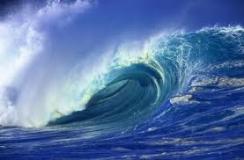Chasing waves
ToggleChasing waves

There are plenty of device formats to capture energy from waves as they roll past – they include small hinged devices that connect directly to the seabed and sway back and forth, and loosely moored “heaving buoys” that move up and down in deeper water where wave energy can be greater. But no-one has yet cracked the perfect wave-energy device, despite many applying their brains to the area, notes Prof Ringwood. “There is all types of everything out there - over 200 prototype devices have been reported, and there are a lot more ideas swimming around people’s minds,” he says. “Wave energy is one of those things that attracts people and there isn’t a year goes by without someone knocking on my door to tell me about their idea.”
One of the hurdles is that wave energy is more complicated to harness than wind, and, as of yet, there is no one design that works well in all conditions, notes Prof Ringwood. “Wind energy is flowing in the same direction all the time and so all that is needed is a very good turbine,” he explains, adding that wind turbines are instantly recognisable structures. “Everyone can picture a wind turbine, but there is no classic design for a wave energy device. To date, there is no globally accepted methodology and there are no truly commercial devices in operation in the ocean at the moment.”
Prof Ringwood’s research is focused on two areas – finding the perfect shape for a wave energy device, and forecasting on-coming waves to allow the device maximise the energy take-off from the wave. “We don’t design devices from scratch, instead we work with device developers to put intelligence into their devices that help them adapt to different sea climates,” he explains.
The science of hydrodynamics connects the wave profile with the device’s response and his team uses it to understand the mechanism by which captured energy can be maximised. One way to ensure a device can get the best from a wave is to monitor its motion, and to forecast the size and energy of waves that are coming towards it.
“We forecast waves about 20 seconds into the future - on the West Coast of Ireland that’s about two full waves. This forecast is then fed into the wave energy device and used to maximise the energy take-off from the wave when it arrives.” They also forecast to a longer timescale. “In addition to the wave-by-wave variation in the sea, the sea state changes over periods of hours and days. One day the sea may be relatively calm, while a large swell may develop 24 hours later” notes Prof Ringwood. “The challenge is to adapt the device so that it can maximize it’s energy conversion across all sea conditions, while maintaining the structural integrity of the device in violent seas.”
So, how do you optimise a device to get the most out of a wave? Strategies often centre on the “power takeoff”, which is the part of the device that harnesses the kinetic and potential energy of waves so it can be converted into electrical energy and fed on to a grid. “Waves impact the device, causing it to move,” explains Ringwood. “In order to take power out we need to have something moving relative to something else.” By forecasting the intensity of the incoming wave, the device can gear itself to best take advantage, he notes. “When we know there is a big wave coming, we put a lot of resistance into the power takeoff because there’s a lot of force to drive it. This has then to be modified for smaller waves - if there is a lot of resistance nothing is going to move - so it’s a bit like gearing in that sense, when a big wave is coming we gear it up high and get a lot of energy converted.”
A key to maximising the converted energy is the control system, which Ringwood’s team design to combine the forecasting algorithm with the power takeoff in order to optimise the device for its intended location. “We have been using numerical optimisation algorithms to evolve the shape, mass or geometry of the device so that together with the control system it is optimal for the prevailing conditions, as well as being able to adapt on a wave-to-wave basis” explains Prof Ringwood, whose lab currently works with Irish company, Wavebob and has links with research groups in the UK and France. “The right control system will double the amount of energy extracted from the wave,” he explains. One commercial size wave energy device on its own can generate around a megawatt of power, a large wind turbine will turn out under 10 megawatts and a typical power station around 300 megawatts, so such devices will have to be deployed in large numbers to make them economically viable, he explains.
Most likely, wave devices will be co-located with other renewable options, such as wind and tidal devices to overcome variability in the availability of resources like wind, and Ringwood’s group has studied the potential at sites off the west of Ireland. “Co-location of energy sources is hugely advantageous from an intermittency perspective. Off the West Coast of Ireland, for example, the optimal mix is 60 per cent wave and 40 per cent wind,” he says. “It doesn’t make the variability zero but it minimises it and it does significantly better than wind alone.”
